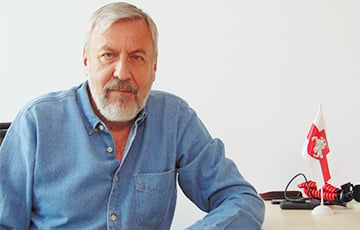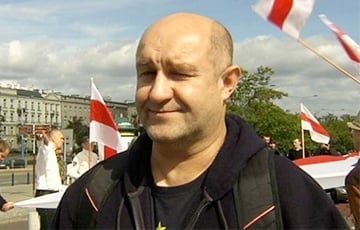NATO Needs Belarus
13- Andrei Sannikov
- 19.06.2024, 14:06
- 11,674

It's necessary to deprive Russia of the "Belarusian Balcony".
Charter97.org presents articles from the book by the European Belarus Foundation. Andrei Sannikov, the European Belarus Civil Campaign leader, wrote this article.
Two high-profile geopolitical events took place at the end of the 20th century. This significantly influenced the post-war security architecture: the fall of the Berlin Wall in 1989, which marked the unification of Germany, and the collapse of the totalitarian Soviet empire.
The security void of the 90s
After the collapse of the Soviet Union in 1991 and the re-emergence of independent states, the issue of changing security architecture in Europe was recognized as a crucial one but no reliable solution was found.
The complexity of the challenges that the newly independent states were facing was not realized either by these states themselves or by the outside democratic world and their institutions.
The end of the Cold War was perceived as the overall victory of the West, of its “soft power’, and the mission was to be completed with resolving the problem of “hard power”, left after the confrontation of the two political systems.
In other words, it was deemed sufficient to deal with huge arsenals of conventional weapons in Europe with the help of The Conventional Forces in Europe (CFE) Treaty and confidence building measures and to ensure control over Soviet nuclear weapons by adapting the nuclear disarmaments treaties concluded between the USSR and the USA.
International security and nuclear and conventional disarmament were not at the top of the list of priorities of the newly independent states. State-building challenges, pressing economic issues, the necessity to introduce reforms and the lack of resources dictated the real hierarchy of priorities.
Past mistakes that lead to today’s catastrophe
The independent states that re-emerged after the collapse of the USSR, had to conduct difficult security negotiations with the West and between themselves under pressing and more burning problems. No wonder under the pressure of the circumstances, many mistakes were made, and many strategic decisions were taken in a hurry.
One of the gravest mistakes was the approval of Russia’s succession of the USSR in the UN Security Council and other international organizations. The approval was the result of Russia cheating during the negotiations and literally faking the document that other Commonwealth of Independent States (CIS) members signed without knowing exactly what they were signing [1].
Other permanent members of the UN Security Council supported Russia’s foul play and recognized its status as the successor of the totalitarian state thus giving a lot of international leverage to the unpredictable entity still heavily intoxicated with imperialism. (Imagine there is no Russia as a permanent member in the UN Security Council today! International peace and security would be in much better shape).
The democratic world and world leaders in the early 90s were viewing Russia as an emerging democracy and giving it much more leeway in international affairs than was reasonably acceptable. Besides, the free-market world was interested in the huge Russian market and was willing to bend the rules a little bit to have that market.
Thus, when Russia invented the term “blizhneye zarubezhye” ("the near abroad"), the West promptly translated it as “near abroad” and recognized it as a political reality thus helping to preserve Russia’s domination in the post-Soviet area.
The attempts to start meaningful discussion on the future European security, let alone broader international security, were not serious despite the new possibilities that were created after the changed geopolitical situation and the new, more open channels of communication between former rivals.
The relations between the remaining superpower, USA, and what remained of the other superpower, Russia, became more transparent but still with a substantial degree of suspicion on both sides.
Despite all proper declarations about commitment to democracy, rule of law and respect for the sovereignty of its neighbours, Russia never wished to let them go and considered all newly independent states as its “sphere of influence”.
New Possibilities and New Divisions
The collapse of the Soviet Union meant the inevitable dissolution of the Warsaw Pact [2].
The geopolitical changes at the end of the 20th century, which were supposed to eradicate dividing lines between East and West, didn’t produce the desired result and in some cases created new divisions between countries of the former Eastern bloc and the countries of the former Soviet Union. The countries of the former Warsaw Pact and the three Baltic states knew that they wanted to be integrated into the West and were moving in this direction at different speeds but with determination.
Former parts of the USSR couldn’t afford themselves such a luxury as a free geopolitical choice. They had to deal with their common interdependence and dependence on Russia first. To some extent, European republics of the former USSR, by agreeing to establish CIS and to subordinate themselves to Russian domination, made a decisive contribution to a relatively safe passage of Central European countries from the political East to the political West.
In the 90s those dividing lines didn’t seem to be dangerous but gradually they were becoming more distinct again, separating part of Europe from the whole. The search for new security arrangements eventually resulted in two tendencies that roughly shaped the situation in the region in the 21st century.
These tendencies had opposite vectors:
– one was voluntary accession to the North Alliance of the former Warsaw Pact members supported by the population of those countries;
– another was the new military pact hastily created and controlled by Russia where several CIS countries were coerced into signing the Collective Security Treaty (CST) [3].
It is worth noting that the CST was signed much earlier than the first enlargement of NATO which occurred in 1998.
NATO in early 1994 established the Partnership For Peace (PfP) program by which, according to US President Clinton, NATO would give way for countries in Eastern Europe, including those that were part of the Soviet Union and even Russia itself, to work together "for the best possible future for Europe" [4]. That was an attempt from the side of NATO that was trying to find some ground for cooperation in the area of security with Russia and the other newly independent states. It was reluctantly accepted by Russia. However Central European states were not happy with the program, fearing that it could become an obstacle to their full membership.
These countries also were very cautious with Russia, fearing retaliation, and didn’t openly declare outright their NATO ambitions. At one moment Poland even put on the table an idea of a "NATO-bis," or a shadow NATO, for East Central Europe.
The hesitancy and cautiousness of former Warsaw Pact members was understandable: firstly they needed to get rid of Soviet troops on their territories, which was not an easy exercise, fraught with chaos and risks. When that was eventually achieved, the road to NATO was cleared and Central European countries led by the Visegrad Group started their accession to the Alliance.
What about Belarus?
Similar to all the other independent states that emerged after the collapse of the USSR (except Baltic states, of course), Belarus was not able to claim its NATO aspiration even if it would have wanted to do so. In the early 90s, Belarus became independent but was not free. The democrats had never been in power in Belarus. The politics were affected by the retrograde communist majority in the parliament and the government, and the rise of Lukashenka. That’s why Belarus was not able to formulate any free and independent security concept.
However, Belarus was a net contributor to European and international security by playing a constructive role in security and disarmament negotiations on conventional forces and nuclear arsenals of the former USSR.
Russian military expansion in Georgia in 2008 and Ukraine in 2014, that went practically unpunished, was understood by Putin as a weakness of the West and served as a basis for his decision for a full-fledged war against Ukraine that started in February 2022.
Other factors also paved the way for the unprecedented bloody war in Europe.
One of these factors was the dictatorship of Lukashenka in Belarus, which in many ways served as a model for the Putin regime and provided all the necessary conditions including logistics, for Russian aggression.
Dictatorship always means war, be it the war of dictators against their own people or, as in the case of the Russian attack on Ukraine, the monstrous war against the neighbours. The most efficient way to prevent war is to get rid of the dictatorships.
Despite a horrendous record of human rights abuses, even political killings, Lukashenka was allowed to live quite comfortably for almost 30 years, easily surviving short periods of “sanctions” that were so mild until 2020. Even in 2020, when there was a revolution in Belarus, the reaction of the West was very slow and not effective. Surviving the revolution and brutally cracking down on the protesters, Lukashenka eagerly provided the territory of Belarus to his fellow dictator Putin to attack Ukraine. The war against Ukraine had been prepared quite openly during large-scale Russian-Belarusian military exercises on the territory of Belarus. The West preferred not to see the dangers of future war in these drills.
There is no alternative to NATO
The barbaric Russian war unleashed on Ukraine made it crystal clear what kind of security Europe needed.
Europe is threatened by Russia and protected by the North Atlantic Treaty Organization. As simple as that.
All the efforts to engage Russia on common security, all attempts “not to alienate” Russia, were nothing else but appeasement of a belligerent dictatorship.
Ukraine was aware of the danger posed by Russia, it has tried for many years to get a positive and definite decision on its membership in NATO. The Bucharest Summit of the Alliance in 2008 is often blamed for not meeting the expectations of Georgia and Ukraine. This prompted Russia to invade Georgia that same year and Ukraine in 2014. However, it was not the denial of MAP (membership action plan) per se that was the failure of Bucharest, but the yielding to Putin who put up an ultimatum to stop future NATO expansion, and after it was met, he was allowed to speak at the Summit to further humiliate Georgia and Ukraine.
It was a hard lesson for NATO that mishandled the whole situation in 2008. It was even harder, tragic, and lethal for Ukraine where people are today sacrificing their lives to save their country and the whole of Europe from the ruthless murderers from the East.
Ukraine has a legitimate right to demand an urgent decision on its membership in NATO and such a decision should follow promptly after Ukraine wins its war against Russia.
At the same time, it must be said that lasting peace is possible in the region and Europe only with a free and democratic Ukraine and a free and democratic Belarus.
The geopolitical significance of Belarus
Belarus holds an extremely important place in Europe in many respects. Its geostrategic importance is due to two geographical regions adjacent to Belarus in the east and the west. These are the Smolensk Gate and the Suwalki Gap.
The Smolensk Gate, the area between the Western Dvina and Dnieper rivers, is one of the main strategic corridors important for cross-border trade between East and West, and it is important not only for Russia but also for the second economy in the world – China.
At the same time, the Belarusian Smolensk Gate is the route through which the Russian Empire repeatedly invaded Europe and through which the Russian Federation today invaded Ukraine with the goal of taking Kyiv.
It is known from history that when Russia began its invasion of Europe through the Smolensk Gate, it reached the Vistula River and went further – to the Elbe and Danube.
The second geostrategic area, the Suwalki Gap, acquired special significance after the collapse of the USSR and the Warsaw Pact. The Gap is extremely important for the security of the Baltic region since it separates Belarus and the Russian exclave Kaliningrad. This Gap is the only road and rail link between Poland, Central Europe and the Baltic states. In the event of an invasion, the Gap would cut off the three countries from the mainland of Europe. For these reasons some experts call the Suwalki Gap “NATO’s Achilles heel.”
During periods of tension between Russia and the West, Belarus becomes a key geopolitical factor. It depends on its policy whether the situation will escalate (if Belarus sides with Russia), or whether a detente is possible (if Belarus becomes democratic and rejoins Europe).
Inevitable security choice for Belarus
Since the renewed independence of Belarus, different security options were discussed to find a workable solution before the time comes for a free and qualified choice on security issues.
For quite a long time many democratic opposition politicians and groups were contemplating the idea of a Baltic-Black Sea Union, put forward in 1992 by the Belarusian Popular Front, as a buffer to international formation without NATO and Russia’s military bases.
Something similar was offered by Ukraine. In April 1993, Kyiv prepared the Central and East European Space of Stability and Security (CEESSS) project [5].
Clearly, those were attempts to find a security arrangement that would protect Eastern Europe from Russia. They didn’t work, even in Ukraine although the country was much more independent from Russia.
That geopolitical concept in the form of the Intermarium exists today within the EU (alas without Ukraine and Belarus), more as an economic project. It is clear that for the European countries outside the European Union, it cannot be a security solution.
The war that Russia unleashed against Ukraine and the reaction of the world, has illustrated that all regional arrangements are shaky and unreliable constructions in the face of the aggressiveness of Russia. Russia being a country that can easily break all its international obligations and denounce all security and disarmament treaties and agreements.
NATO was the only security entity that came to help Ukraine and has been rescuing the country ever since.
Ukraine rightfully has started to negotiate security guarantees aimed at protecting the country from the repetition of Russian aggression in the future. Such guarantees are impossible if they do not include a free and democratic Belarus.
Recent history demonstrates that Belarus, under the dictatorship, is used by the perpetual aggressor of the Kremlin as a springboard for war against Europe, and will continue to be used until the country is free and democratic.
Free Belarus will need to become a NATO member as soon as possible to protect its independence and prosperity.
At the same time, NATO needs Belarus to prevent future Russian aggression from this “balcony” and to seal the obvious gap in European security.
____________________________________________
Notes:
1. https://www.un.org/en/about-us/member-states/russian-federation
2. Warsaw Pact- a collective defense treaty established by the Soviet Union and seven other Soviet satellite states in Central and Eastern Europe: Albania, Bulgaria, Czechoslovakia, East Germany, Hungary, Poland and Romania (Albania withdrew in 1968).
3. The Treaty was signed on May 15, 1992 in Tashkent by the Heads of six countries: Armenia, Kazakhstan, Kyrgyzstan, Russia, Tajikistan and Uzbekistan. In December 1993 after a lot of pressure from Russia and from communist forces inside the country Belarus had signed the Treaty as well. Despite the similar pressure and even blackmail from the side of Russia, Ukraine managed to stay away from this trap.
4. https://heinonline.org/HOL/LandingPage?handle=hein.journals/dsptch13&div=20&id=&page
5. The CEESSS had to include the Baltic States, Ukraine, Belarus, Poland, Czech Republic, Slovakia, Hungary, Austria, Bulgaria and Romania.
Reference
Andrei Sannikov is the Chairman of the European Belarus Foundation.
He is a career diplomat. He was working at the Ministry of Foreign Affairs of Belarus including the Deputy Foreign Minister position in 1995-1996. He headed Belarusian delegations at the conventional and nuclear disarmament negotiations.
Andrei Sannikov resigned in protest against Lukashenka's policy in 1996.
He was a candidate in the 2010 presidential election in Belarus, and had the second-highest percentage of the votes. He was imprisoned in the Minsk KGB facility for peacefully protesting at a demonstration after the elections. After his release in 2012 he had to go into exile. He’s living and working in Europe.











